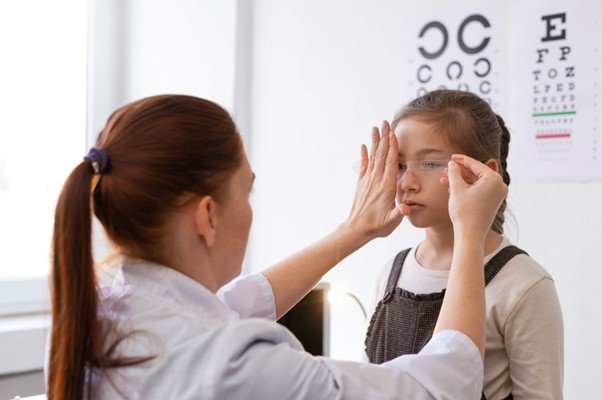Amblyopia, often called “lazy eye,” is a common vision problem in children. Early amblyopia detection is important because treatment works best when started early. In this blog, we will explain amblyopia symptoms, how to spot early signs, and when to seek help. Understanding lazy eye signs can help protect your child’s vision.
What Is Amblyopia?
Amblyopia is a condition where one eye does not see as well as the other. This happens because the brain and the eye do not work together properly. As a result, the brain starts to ignore signals from the weaker eye. Over time, this can cause lasting vision problems in children if not treated early. Amblyopia usually starts in childhood, but it can affect adults if left untreated.
Common Symptoms of Amblyopia
It is not always easy to notice amblyopia symptoms, especially in young children. However, there are some early signs you can watch for. Early amblyopia detection can make a big difference. Here are some common symptoms:One eye wanders: Sometimes, one eye may drift inward or outward. This is a classic lazy eye sign.Poor depth perception: Children may have trouble judging how far away things are. For example, they may bump into objects or struggle with catching a ball.Squinting or shutting one eye: Kids might squint or close one eye to see better, especially in bright light.Tilting the head: Some children tilt their heads to use their stronger eye.Complaints of blurry vision: Children may say things look blurry or fuzzy, but often they do not notice the problem themselves.Frequent eye rubbing: This can be a sign of eye strain or discomfort.
Sometimes, these symptoms are hard to spot. Therefore, regular eye exams are important for early amblyopia detection.
How Is Amblyopia Diagnosed?
Eye doctors use simple tests to check for amblyopia. First, they will ask about your child’s vision and any symptoms. Next, they will test each eye separately. For example, your child may be asked to read letters or look at pictures. The doctor may also use special tools to check how the eyes move and focus. In some cases, eye drops are used to help the doctor see inside the eye. According to the CDC, early diagnosis is key to preventing long-term vision loss.
When to Seek Medical Help
If you notice any lazy eye signs or vision problems in children, do not wait. Early amblyopia detection gives the best chance for good vision. You should consult an eye specialist if:Your child’s eyes do not move togetherOne eye seems to wander or driftYour child squints, tilts their head, or covers one eye oftenThere is a family history of amblyopia or other eye problemsYour child fails a vision screening at school or during a checkup
Even if you are unsure, it is better to get your child’s eyes checked. Early help can prevent lasting vision loss.
Frequently Asked Questions about Amblyopia Symptoms
Can amblyopia cause permanent vision loss?
Yes, if not treated early, amblyopia can lead to permanent vision problems. However, early treatment often helps restore normal vision.
Is amblyopia always easy to spot?
No, sometimes there are no clear symptoms. That is why regular eye exams are important, even if your child seems fine.
Can adults have amblyopia?
Yes, but it usually starts in childhood. Treatment is most effective when started early, but adults can still benefit from care.
Conclusion and Next Steps
In summary, amblyopia symptoms can be hard to notice, but early signs like wandering eyes or poor depth perception are important. Regular eye exams help with early amblyopia detection. If you see any lazy eye signs or vision problems in children, do not wait. Consult an eye specialist for personalized guidance.

